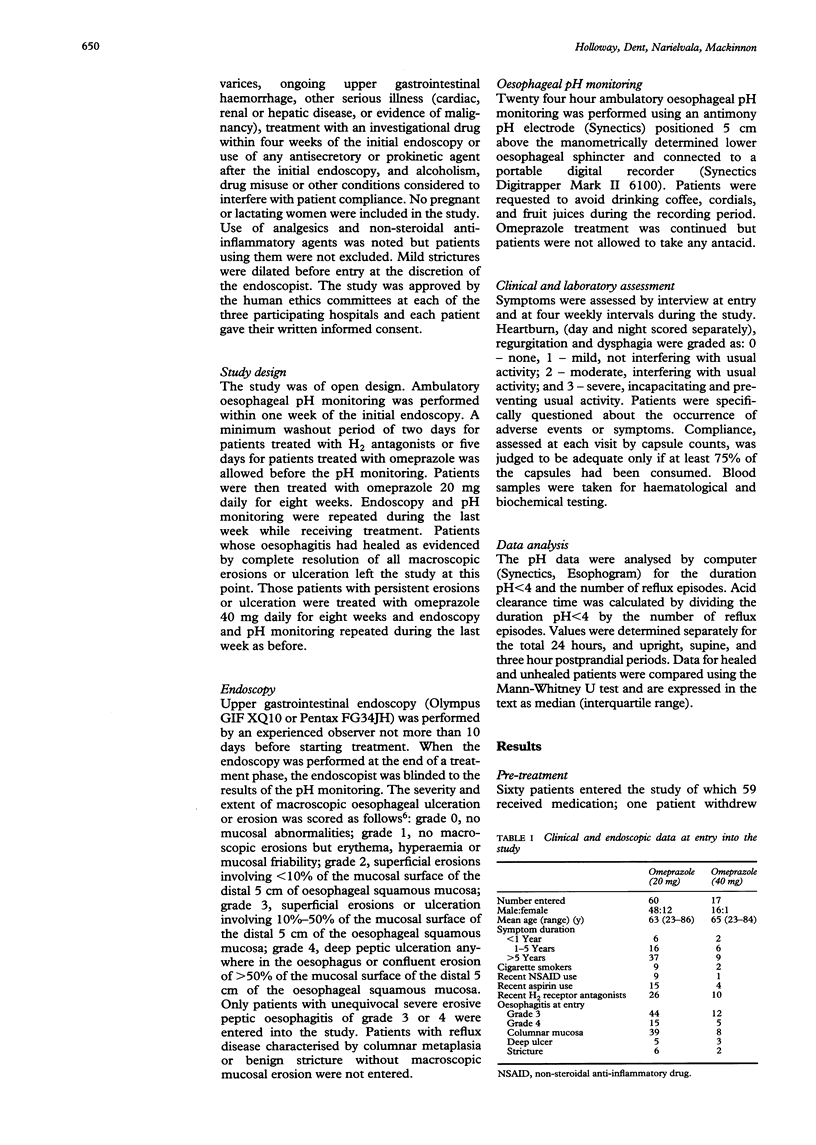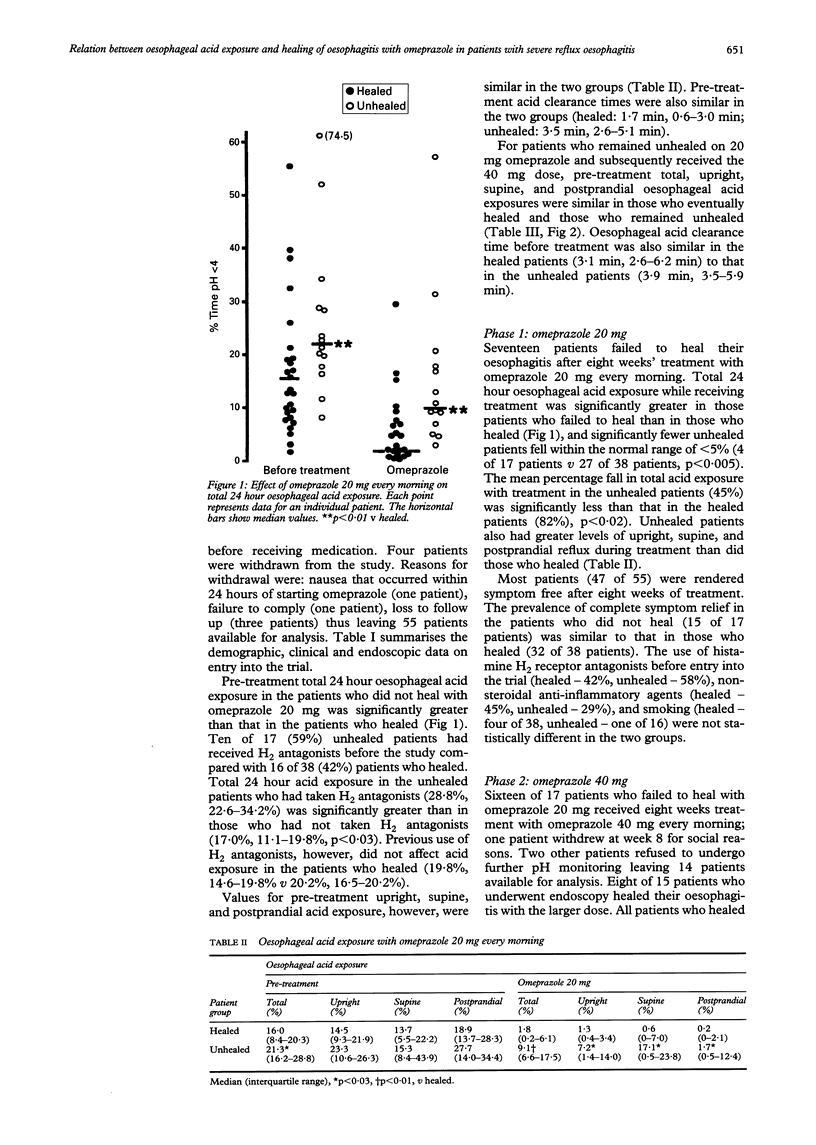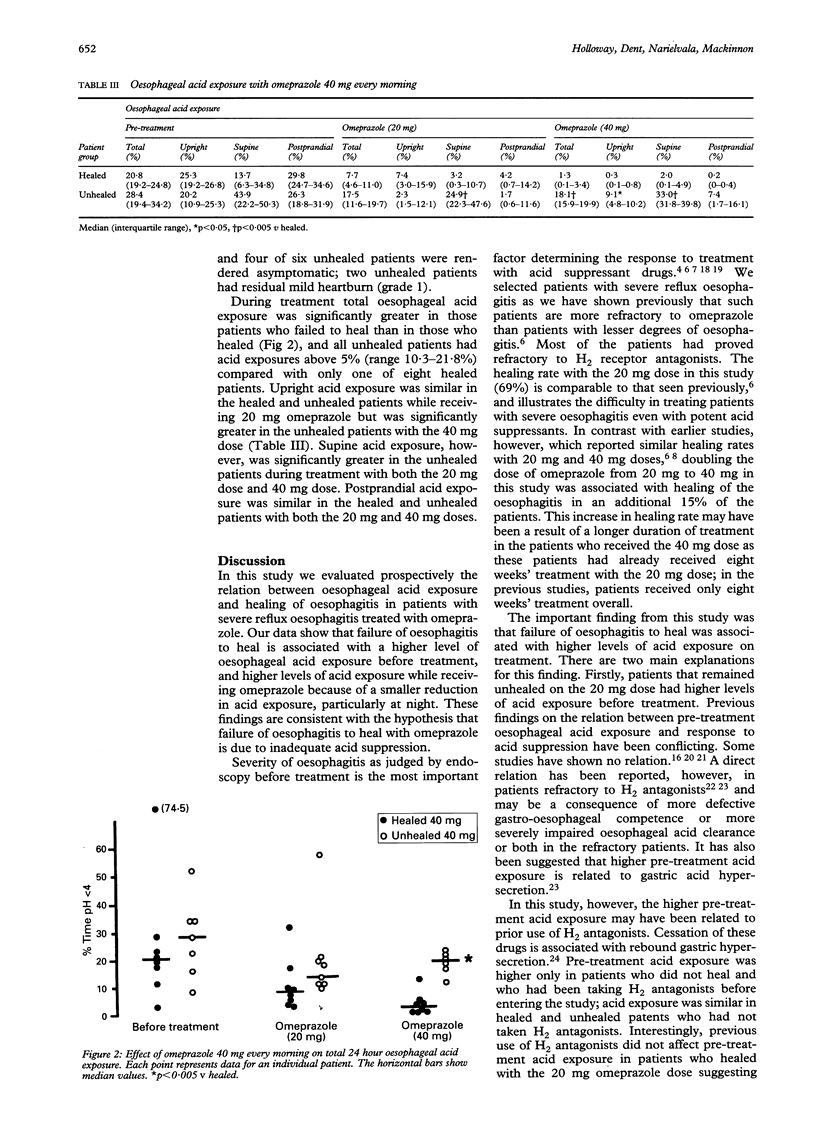Abstract
BACKGROUND/AIMS--Reducing oesophageal acid exposure by suppressing acid secretion with omeprazole is highly effective in healing reflux oesophagitis. Some patients with severe oesophagitis, fail to heal and whether this results from inadequate acid suppression or other factors is unclear. The aim of this study, was to investigate the relation between oesophageal acid exposure and healing in patients with severe reflux oesophagitis treated with omeprazole. METHODS--Sixty one patients with grade 3 or 4 ulcerative oesophagitis were treated for eight weeks with omeprazole 20 mg every morning. Those patients unhealed at eight weeks were treated with 40 mg every morning for a further eight weeks. Endoscopy and 24 hour oesophageal pH monitoring were performed before treatment and at the end of each treatment phase while receiving treatment. RESULTS--Thirty per cent of patients failed to heal with the 20 mg dose. Unhealed patients had greater total 24 hour oesophageal acid exposure before treatment, and while receiving treatment also had greater acid exposure and a smaller reduction in acid exposure than did patients who healed. Forty seven per cent of the unhealed patients also failed to heal with the 40 mg dose. These patients had similar levels of acid exposure before treatment to those who healed, but had greater acid exposure while receiving treatment, particularly at night when supine. CONCLUSIONS--Patients with severe ulcerative oesophagitis who are refractory to omeprazole have greater oesophageal acid exposure while receiving treatment than responding patients. This is due to a reduced responsiveness to acid suppression, and is likely to be an important factor underlying the failure of the oesophagitis to heal.
Full text
PDF





Selected References
These references are in PubMed. This may not be the complete list of references from this article.
- Bardhan K. D., Morris P., Thompson M., Dhande D. S., Hinchliffe R. F., Jones R. B., Daly M. J., Carroll N. J. Omeprazole in the treatment of erosive oesophagitis refractory to high dose cimetidine and ranitidine. Gut. 1990 Jul;31(7):745–749. doi: 10.1136/gut.31.7.745. [DOI] [PMC free article] [PubMed] [Google Scholar]
- Barlow A. P., DeMeester T. R., Ball C. S., Eypasch E. P. The significance of the gastric secretory state in gastroesophageal reflux disease. Arch Surg. 1989 Aug;124(8):937–940. doi: 10.1001/archsurg.1989.01410080069011. [DOI] [PubMed] [Google Scholar]
- Bell N. J., Hunt R. H. Role of gastric acid suppression in the treatment of gastro-oesophageal reflux disease. Gut. 1992 Jan;33(1):118–124. doi: 10.1136/gut.33.1.118. [DOI] [PMC free article] [PubMed] [Google Scholar]
- Bianchi Porro G., Pace F., Sangaletti O. Pattern of acid reflux in patients with reflux esophagitis 'resistant' to H2-receptor antagonists. Scand J Gastroenterol. 1990 Aug;25(8):810–814. doi: 10.3109/00365529008999219. [DOI] [PubMed] [Google Scholar]
- Chiverton S. G., Howden C. W., Burget D. W., Hunt R. H. Omeprazole (20 mg) daily given in the morning or evening: a comparison of effects on gastric acidity, and plasma gastrin and omeprazole concentration. Aliment Pharmacol Ther. 1992 Feb;6(1):103–111. doi: 10.1111/j.1365-2036.1992.tb00550.x. [DOI] [PubMed] [Google Scholar]
- Collen M. J., Johnson D. A., Sheridan M. J. Basal acid output and gastric acid hypersecretion in gastroesophageal reflux disease. Correlation with ranitidine therapy. Dig Dis Sci. 1994 Feb;39(2):410–417. doi: 10.1007/BF02090216. [DOI] [PubMed] [Google Scholar]
- Collen M. J., Lewis J. H., Benjamin S. B. Gastric acid hypersecretion in refractory gastroesophageal reflux disease. Gastroenterology. 1990 Mar;98(3):654–661. doi: 10.1016/0016-5085(90)90285-9. [DOI] [PubMed] [Google Scholar]
- Dehn T. C., Shepherd H. A., Colin-Jones D., Kettlewell M. G., Carroll N. J. Double blind comparison of omeprazole (40 mg od) versus cimetidine (400 mg qd) in the treatment of symptomatic erosive reflux oesophagitis, assessed endoscopically, histologically and by 24 h pH monitoring. Gut. 1990 May;31(5):509–513. doi: 10.1136/gut.31.5.509. [DOI] [PMC free article] [PubMed] [Google Scholar]
- Frislid K., Aadland E., Berstad A. Augmented postprandial gastric acid secretion due to exposure to ranitidine in healthy subjects. Scand J Gastroenterol. 1986 Jan;21(1):119–122. doi: 10.3109/00365528609034634. [DOI] [PubMed] [Google Scholar]
- Gotley D. C., Morgan A. P., Cooper M. J. Bile acid concentrations in the refluxate of patients with reflux oesophagitis. Br J Surg. 1988 Jun;75(6):587–590. doi: 10.1002/bjs.1800750632. [DOI] [PubMed] [Google Scholar]
- Havelund T., Laursen L. S., Skoubo-Kristensen E., Andersen B. N., Pedersen S. A., Jensen K. B., Fenger C., Hanberg-Sørensen F., Lauritsen K. Omeprazole and ranitidine in treatment of reflux oesophagitis: double blind comparative trial. Br Med J (Clin Res Ed) 1988 Jan 9;296(6615):89–92. doi: 10.1136/bmj.296.6615.89. [DOI] [PMC free article] [PubMed] [Google Scholar]
- Hetzel D. J., Dent J., Reed W. D., Narielvala F. M., Mackinnon M., McCarthy J. H., Mitchell B., Beveridge B. R., Laurence B. H., Gibson G. G. Healing and relapse of severe peptic esophagitis after treatment with omeprazole. Gastroenterology. 1988 Oct;95(4):903–912. doi: 10.1016/0016-5085(88)90162-x. [DOI] [PubMed] [Google Scholar]
- Hirschowitz B. I. A critical analysis, with appropriate controls, of gastric acid and pepsin secretion in clinical esophagitis. Gastroenterology. 1991 Nov;101(5):1149–1158. doi: 10.1016/0016-5085(91)90062-p. [DOI] [PubMed] [Google Scholar]
- Hirschowitz B. I. Acid and pepsin secretion in patients with esophagitis refractory to treatment with H2 antagonists. Scand J Gastroenterol. 1992 Jun;27(6):449–452. doi: 10.3109/00365529209000104. [DOI] [PubMed] [Google Scholar]
- Joelsson B., Johnsson F. Heartburn--the acid test. Gut. 1989 Nov;30(11):1523–1525. doi: 10.1136/gut.30.11.1523. [DOI] [PMC free article] [PubMed] [Google Scholar]
- Klinkenberg-Knol E. C., Meuwissen S. G. Combined gastric and oesophageal 24-hour pH monitoring and oesophageal manometry in patients with reflux disease, resistant to treatment with omeprazole. Aliment Pharmacol Ther. 1990 Oct;4(5):485–495. doi: 10.1111/j.1365-2036.1990.tb00495.x. [DOI] [PubMed] [Google Scholar]
- Koop H., Hotz J., Pommer G., Klein M., Arnold R. Prospective evaluation of omeprazole treatment in reflux oesophagitis refractory to H2-receptor antagonists. Aliment Pharmacol Ther. 1990 Dec;4(6):593–599. doi: 10.1111/j.1365-2036.1990.tb00507.x. [DOI] [PubMed] [Google Scholar]
- Lanas A., Hirschowitz B. I. Significant role of aspirin use in patients with esophagitis. J Clin Gastroenterol. 1991 Dec;13(6):622–627. doi: 10.1097/00004836-199112000-00005. [DOI] [PubMed] [Google Scholar]
- Lanzon-Miller S., Pounder R. E., Hamilton M. R., Chronos N. A., Ball S., Mercieca J. E., Olausson M., Cederberg C. Twenty-four-hour intragastric acidity and plasma gastrin concentration in healthy subjects and patients with duodenal or gastric ulcer, or pernicious anaemia. Aliment Pharmacol Ther. 1987 Jun;1(3):225–237. doi: 10.1111/j.1365-2036.1987.tb00622.x. [DOI] [PubMed] [Google Scholar]
- Lieberman D. A. 24-hour esophageal pH monitoring before and after medical therapy for reflux esophagitis. Dig Dis Sci. 1988 Feb;33(2):166–171. doi: 10.1007/BF01535728. [DOI] [PubMed] [Google Scholar]
- Lind T., Cederberg C., Idström J. P., Lönroth H., Olbe L., Lundell L. 24-hour intragastric acidity and plasma gastrin during long-term treatment with omeprazole or ranitidine in patients with reflux esophagitis. Scand J Gastroenterol. 1991 Jun;26(6):620–626. doi: 10.3109/00365529109043636. [DOI] [PubMed] [Google Scholar]
- Lundell L., Backman L., Ekström P., Enander L. H., Fausa O., Lind T., Lönroth H., Sandmark S., Sandzén B., Unge P. Omeprazole or high-dose ranitidine in the treatment of patients with reflux oesophagitis not responding to 'standard doses' of H2-receptor antagonists. Aliment Pharmacol Ther. 1990 Apr;4(2):145–155. doi: 10.1111/j.1365-2036.1990.tb00459.x. [DOI] [PubMed] [Google Scholar]
- Marciano-D'Amore D. A., Paterson W. G., Da Costa L. R., Beck I. T. Omeprazole in H2 receptor antagonist-resistant reflux esophagitis. J Clin Gastroenterol. 1990 Dec;12(6):616–620. doi: 10.1097/00004836-199012000-00003. [DOI] [PubMed] [Google Scholar]
- Mulholland M. W., Reid B. J., Levine D. S., Rubin C. E. Elevated gastric acid secretion in patients with Barrett's metaplastic epithelium. Dig Dis Sci. 1989 Sep;34(9):1329–1334. doi: 10.1007/BF01538064. [DOI] [PubMed] [Google Scholar]
- Olden K., Triadafilopoulos G. Failure of initial 24-hour esophageal pH monitoring to predict refractoriness and intractability in reflux esophagitis. Am J Gastroenterol. 1991 Sep;86(9):1142–1146. [PubMed] [Google Scholar]
- Robertson D. A., Aldersley M. A., Shepherd H., Lloyd R. S., Smith C. L. H2 antagonists in the treatment of reflux oesophagitis: can physiological studies predict the response? Gut. 1987 Aug;28(8):946–949. doi: 10.1136/gut.28.8.946. [DOI] [PMC free article] [PubMed] [Google Scholar]
- Robertson D., Aldersley M., Shepherd H., Smith C. L. Patterns of acid reflux in complicated oesophagitis. Gut. 1987 Nov;28(11):1484–1488. doi: 10.1136/gut.28.11.1484. [DOI] [PMC free article] [PubMed] [Google Scholar]
- Sandmark S., Carlsson R., Fausa O., Lundell L. Omeprazole or ranitidine in the treatment of reflux esophagitis. Results of a double-blind, randomized, Scandinavian multicenter study. Scand J Gastroenterol. 1988 Jun;23(5):625–632. doi: 10.3109/00365528809093923. [DOI] [PubMed] [Google Scholar]
- Savarino V., Mela G. S., Zentilin P., Cutela P., Mele M. R., Vigneri S., Celle G. Variability in individual response to various doses of omeprazole. Implications for antiulcer therapy. Dig Dis Sci. 1994 Jan;39(1):161–168. doi: 10.1007/BF02090077. [DOI] [PubMed] [Google Scholar]
- Sharma B. K., Walt R. P., Pounder R. E., Gomes M. D., Wood E. C., Logan L. H. Optimal dose of oral omeprazole for maximal 24 hour decrease of intragastric acidity. Gut. 1984 Sep;25(9):957–964. doi: 10.1136/gut.25.9.957. [DOI] [PMC free article] [PubMed] [Google Scholar]
- Sontag S. J., Hirschowitz B. I., Holt S., Robinson M. G., Behar J., Berenson M. M., McCullough A., Ippoliti A. F., Richter J. E., Ahtaridis G. Two doses of omeprazole versus placebo in symptomatic erosive esophagitis: the U.S. Multicenter Study. Gastroenterology. 1992 Jan;102(1):109–118. doi: 10.1016/0016-5085(92)91790-b. [DOI] [PubMed] [Google Scholar]
- Tytgat G. N., Nicolai J. J., Reman F. C. Efficacy of different doses of cimetidine in the treatment of reflux esophagitis. A review of three large, double-blind, controlled trials. Gastroenterology. 1990 Sep;99(3):629–634. doi: 10.1016/0016-5085(90)90947-y. [DOI] [PubMed] [Google Scholar]
- Vantrappen G., Rutgeerts L., Schurmans P., Coenegrachts J. L. Omeprazole (40 mg) is superior to ranitidine in short-term treatment of ulcerative reflux esophagitis. Dig Dis Sci. 1988 May;33(5):523–529. doi: 10.1007/BF01798351. [DOI] [PubMed] [Google Scholar]
- Zeitoun P. Comparison of omeprazole with ranitidine in the treatment of reflux oesophagitis. Scand J Gastroenterol Suppl. 1989;166:83–94. doi: 10.3109/00365528909091250. [DOI] [PubMed] [Google Scholar]
- de Caestecker J. S., Blackwell J. N., Pryde A., Heading R. C. Daytime gastro-oesophageal reflux is important in oesophagitis. Gut. 1987 May;28(5):519–526. doi: 10.1136/gut.28.5.519. [DOI] [PMC free article] [PubMed] [Google Scholar]


